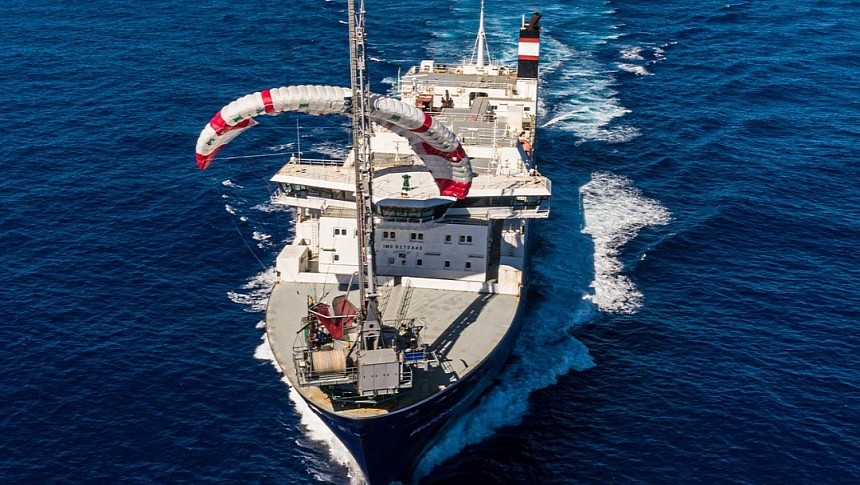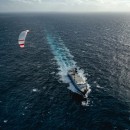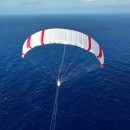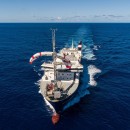Several maritime companies are harnessing the power of the wind to develop innovative ways of saving fuel and lowering emissions levels. Seawing is different from all others as the only automated kite specifically developed for cargo ships by Airseas, the maritime project of aviation giant Airbus.
Airseas is ending the year on a high note. The extensive testing campaign for Seawing reached another milestone with the validation of automated dynamic flights. This performance allows Seawing to save fuel and emissions by 16%, in line with the company's target of 20% for a standard transatlantic cargo delivery.
These sea trials are taking place onboard Ville de Bordeaux, a massive container ship owned by Louis Dreyfus Armateurs. They progressed from the first step, which is the automated takeoff, to traction flights while the kite is in a stationary position and, finally, to the dynamic flight phase.
Seawing is a giant automated kite that works like a parafoil. It can fly 300 meters (984 feet) above sea level, effectively reducing the main engine load for oceangoing commercial vessels. This results in significant fuel consumption and lower levels of GHG emissions.
There's still a lot of work ahead for Seawing. The system will continue to conduct sea trials onboard a different ship. K Line, an important Japanese maritime company, has already purchased five Seawing systems, with an option for a total of 51. Sea trials onboard one of the K Line ships are due to kick off soon.
At the same time, Airseas will conduct complex ground testing at its new R&D (research and development) center in Dakhla, Morocco. Airseas announced last month that it's investing in a state-of-the-art facility. It will include a massive hangar (2,400 square meters/25,800 square feet) and a test bench for testing the Seawing technology and each of its separate components.
The facility's location also plays an important part. Known as a great destination for nautical sports and kitesurfing in particular, Dakhla ensures optimal wind conditions on a regular basis. Since Seawing is basically a giant kite, this would be the perfect place to test its performance.
Seawing was introduced at the end of 2021 as a groundbreaking alternative to traditional static sails. This parafoil wing claims to boast ten times the traction power of conventional sails. It requires minimal space, and it’s compatible with any type of vessel.
It combines the unique properties of a dynamic system with automated technology. The wing is linked to a control pod via a cable, allowing fully automated takeoff, landing, and flight control. The system also includes a digital twin that recreates both the physical ship and the kite. Through sensors, the digital twin stays permanently connected to the physical counterparts. This way, the Seawing system can adjust its position and even optimize the ships' route without human intervention.
These sea trials are taking place onboard Ville de Bordeaux, a massive container ship owned by Louis Dreyfus Armateurs. They progressed from the first step, which is the automated takeoff, to traction flights while the kite is in a stationary position and, finally, to the dynamic flight phase.
Seawing is a giant automated kite that works like a parafoil. It can fly 300 meters (984 feet) above sea level, effectively reducing the main engine load for oceangoing commercial vessels. This results in significant fuel consumption and lower levels of GHG emissions.
There's still a lot of work ahead for Seawing. The system will continue to conduct sea trials onboard a different ship. K Line, an important Japanese maritime company, has already purchased five Seawing systems, with an option for a total of 51. Sea trials onboard one of the K Line ships are due to kick off soon.
At the same time, Airseas will conduct complex ground testing at its new R&D (research and development) center in Dakhla, Morocco. Airseas announced last month that it's investing in a state-of-the-art facility. It will include a massive hangar (2,400 square meters/25,800 square feet) and a test bench for testing the Seawing technology and each of its separate components.
The facility's location also plays an important part. Known as a great destination for nautical sports and kitesurfing in particular, Dakhla ensures optimal wind conditions on a regular basis. Since Seawing is basically a giant kite, this would be the perfect place to test its performance.
Seawing was introduced at the end of 2021 as a groundbreaking alternative to traditional static sails. This parafoil wing claims to boast ten times the traction power of conventional sails. It requires minimal space, and it’s compatible with any type of vessel.
It combines the unique properties of a dynamic system with automated technology. The wing is linked to a control pod via a cable, allowing fully automated takeoff, landing, and flight control. The system also includes a digital twin that recreates both the physical ship and the kite. Through sensors, the digital twin stays permanently connected to the physical counterparts. This way, the Seawing system can adjust its position and even optimize the ships' route without human intervention.







